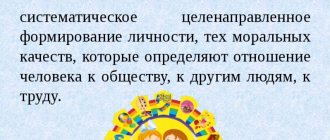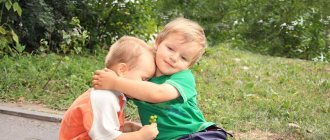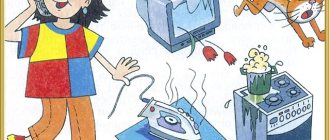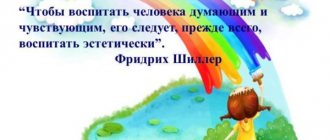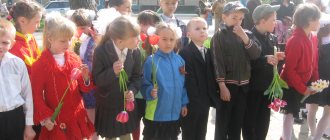Directions of moral development of a younger preschooler
In early preschool age, the development of the body’s mental processes occurs. The child’s capabilities expand: he can independently perform various household operations and master self-service skills. In addition, his social contacts are expanding: the child enters a preschool educational institution, where he interacts with new adults, as well as a group of peers. This requires focusing on developing the foundations of social interaction and establishing positive contacts.
Are you an expert in this subject area? We invite you to become the author of the Directory Working Conditions
The moral development of a younger preschooler is implemented in the following areas:
- Formation of elementary moral ideas. They affect the basics of behavior, its norms, ideas about good and evil, good and bad, right and wrong. The teacher introduces children to different situations and the behavior of their participants, analyzing their moral meaning and significance.
- Formation of the foundations of a culture of behavior. It requires mastering the rules of etiquette, showing politeness and tolerance towards other people. Here, the basics of cultural behavior in everyday life, in play and other activities of the child are mastered.
- Development of the basics of independent activity. They are necessary for the formation of one’s own views and beliefs, and the development of a worldview. Independence develops in everything: from self-service to the performance of various educational and work tasks.
- Formation of moral interaction with adults. Children are taught to respect their elders, listen to them, follow their instructions, and be polite. It is explained to children that an adult requires the child to do something for his own good, and not because he is an authority and does not take into account the child’s opinion.
- Active development of the sensual side of the personality. Children are taught to show their feelings and express them adequately. Emerging feelings and emotions must be manifested in real action. Otherwise, their development is pointless.
- Giving a humanistic orientation to the behavior of a preschooler. There is learning to establish positive social contacts, the formation of the habit of performing actions according to moral principles, the skills of moral interaction with the outside world and their predominance in any area of activity are developed.
Finished works on a similar topic
Course work Moral education of children of primary preschool age 430 ₽ Abstract Moral education of children of primary preschool age 250 ₽ Test work Moral education of children of primary preschool age 240 ₽
Receive completed work or specialist advice on your educational project Find out the cost
Features of the development of the moral sphere in preschool children
Olga Yandaeva
Features of the development of the moral sphere in preschool children
At preschool age, the most favorable conditions are created for the moral development of children . During this period, the child’s system of relationships with adults and peers expands and restructures, types of activities become more complex, and joint activities with peers arise. The child looks closely at the world of adults, beginning to highlight the relationships between people in it. A preschooler comprehends the world of human relations, discovers the laws by which human interaction is built, that is, norms of behavior. In an effort to become an adult, a preschooler subordinates his actions to social norms and rules of behavior.
The leading type of activity is role-playing play, where the child models behavior , actions, and relationships among adults. It brings to the fore the relationships between people and the meaning of their work. By fulfilling roles, the child learns to act in accordance with moral standards accepted in human society.
All moral norms are characterized by the fact that they reinforce a social way of behavior , which preschoolers express as follows: “You cannot deceive adults.”
,
.
” That is, children state what can be done and what cannot be done. about the formation of an understanding of a moral norm if the child explains why the norm must be observed.
In preschool age, there are completely different levels of such understanding. The younger the child, the more often he explains the need to fulfill the norm, referring to the possible consequences for himself or to the demands of adults, for example: “You must tell the truth, otherwise they will find out and punish you.”
,
“We need to share toys.
And then someone will give it to you too .
At the age of 5-7 years, a child understands the social meaning of a moral norm and realizes its objective necessity for regulating relationships between people.
So for an older preschooler , the interests and desires of another person begin to play an increasingly important role. Children of this age use words in their speech that denote moral feelings , but associate them with a specific situation from their own experience, which is explained by the specific imagery of children's thinking.
Fiction plays an important role in the formation of moral feelings in children Research by A. V. Zaporozhets, which was devoted to the study of preschoolers’ perception of fairy tales , made it possible to highlight the following features . The child is not satisfied with uncertain situations when it is not known who is good and who is bad. Children immediately strive to highlight positive heroes and unconditionally accept their position. And in relation to everyone who interferes with the implementation of their plans, they take a sharply negative attitude. When listening to a literary work, the preschooler takes the position “inside it”
.
He strives to imitate his favorite heroes. This is how mechanisms of moral identification , internal action in the imaginary plane, and the child’s personal experience is enriched, because he actively experiences events in which he did not participate.
G. A. Uruntaeva notes that at 3-4 years old a child can already give a correct moral assessment, without comprehending the situation, but transferring his positive and negative attitude to the specific actions of the heroes. At the age of about 4 years, a discrepancy in the emotional and moral attitude towards the hero may be observed. At 4-5 years old the concept of “good”
,
"Badly"
.
Then an assessment of the hero arises based on the content of his actions. The child penetrates into the interaction of the characters and takes into account not only who performed the action, but also to whom it was directed. After 4 years, with the development of empathy and assistance to the hero, moral argumentation .
Now children point out the social significance of actions. Thus, action in an imaginary plane helps the child to come to an understanding of behavior, and the emotional attitude towards the hero begins to separate from the moral assessment of his actions. However, moral feelings , even those that the child knows well, do not immediately begin to guide his behavior. Initially, they are performed only at the request of an adult or in his presence, and are easily violated by a child. Moreover, the baby does not notice this violation and, while negatively assessing such behavior in general, does not apply the negative assessment to himself.
Having mastered the norm, the child, first of all, begins to control his peer. It is easier for him to see and evaluate the presence of moral feelings and the fulfillment of norms by a peer than by himself. Very often he correctly assesses the fulfillment of moral standards by his comrades and is mistaken about himself. Gradually, evaluating a peer, comparing himself with him, listening to the assessment of his actions by adults and comrades, the child approaches the real formation of one or another moral quality .
Older preschoolers increasingly display not pragmatic behavior, when a moral act is associated with self-interest, but selfless behavior, when behavior does not depend on external control, and its motive is moral self-esteem .
At the age of 5-7 years, preschoolers move from spontaneous morality to conscious morality .
For them, a moral norm begins to act as a regulator of relationships between people. An older preschooler understands that the norm must be observed for collective activity to be successful. The need for external control over compliance with the norm on the part of an adult disappears. The child’s behavior becomes moral even in the absence of an adult and if the child is confident in the impunity of his action and does not see any benefit for himself.
In the development of morality, the example of an adult plays an important role. The positive example of parents helps the child easily and unobtrusively learn to live in accordance with the norms accepted in society. A norm that is only declared but not observed by an adult will never influence the child’s actual behavior. The child strictly fulfills one norm in some conditions and violates it in others, without feeling guilty.
In preschool age children’s behavior , since the adult acts as a model, a standard with which the child compares himself and his actions.
A positive moral assessment by an adult gives a positive connotation even to those actions that were usually performed by a child with complete indifference.
When assessing a child’s actions, an adult, with the help of a positive assessment, fixes the correct way of behavior , and with the help of a negative one, he destroys the negative way .
The assimilation of social patterns of behavior in preschool childhood leads to the emergence of “internal authorities”
, representing that level of moral-volitional
development of the child , which provides the possibility of moral actions and deeds.
The assimilation of ethical standards in older preschool age is somewhat different than in younger ones. If children of middle preschool age evaluate the actions of their peers only as bad or good, then six-seven-year-old children are capable of motivated assessment, more accurate and subtle differentiation of behavior. They capture the diversity of moral manifestations : you can make people happy, sad, or show concern in different ways.
This leads to the realization that the morality of an action depends not only on its consequences, but also on its intentions. The manifestation of this need occurs due to the fulfillment of the required norms of behavior, perceived as a prerequisite for obtaining approval from adults, for those relationships in which the preschooler experiences this need.
So, the features of the moral development of children in preschool age are : the formation of the first moral judgments and assessments; initial understanding of the social meaning of a moral norm ; the effectiveness of moral ideas increases ; conscious morality , that is, the child’s behavior begins to be mediated by a moral norm .
Imitability as the basis for the moral development of a younger preschooler
The education of morality in three-year-old children is carried out on the basis of the principle of imitation. It means an active demonstration by adults - teachers and parents - of their own moral behavior in various situations.
Children of primary preschool age are distinguished by their responsiveness and sensory perception of adult behavior. They use imitation of him as the basis for building their line of behavior with others and their attitude towards the world around them.
The moral education of preschoolers, based on their imitation, is implemented through the observance by the teacher and other adults nearby of the following rules of behavior:
- Creating conditions for the formation of a child’s positive emotional state in different situations.
- Showing responsiveness towards the child: in response to suggestions and requests, expressing opinions and needs, showing empathy and mercy.
- Praise the child for various achievements and good deeds.
- Adults’ approval of the child’s display of kindness towards others: assistance, tolerance, respect.
- Negative attitude towards rudeness, aggression, greed of children. An adult needs to express his attitude in adequate forms: to show grief, frustration from such behavior of the child.
- Assisting the child in solving various problems.
- Show respect for the child's individuality.
- Providing assistance in resolving various conflict situations between children.
- Polite relationships with children, teachers, parents.
- Showing joy when another person succeeds or achieves something.
Techniques for developing morality
Many methods of moral education are based on gentle and trusting interaction with children. This relationship includes mutual trust and respect for the child's personality.
Morality is cultivated not only by verbal methods, but also by visual activities. Everyday everyday tasks that require choices and actions play an important role.
Teachers use the following means of moral education:
- Creative means. Here you will need to familiarize children with artistic, musical and literary creativity. Art helps a child to realize and express the feelings that a person experiences in various situations, expressing them through fairy tales, music, and drawings.
- Contact with wildlife, interaction with animals. It is noteworthy that the zoo is poorly suited for the implementation of education - there the animals are locked up, in captivity. It is important to take your child out into nature, into the forest, and get to know the flora and fauna.
- Actually, the child’s activity itself is play, learning, creativity. The child’s already established values are expressed through activities.
- The right environment for the child. Family is the main means for raising a preschooler. There should be no insults, quarrels, or shouting between mom and dad. The child must be surrounded by respect, care, warmth, love - feel all these components towards himself and observe them between parents.
The content of moral education includes the perception of other people, oneself, animals and nature.
There is a high probability that the grown-up child will relate to people and nature in the same way as his parents did when he was a preschooler.
